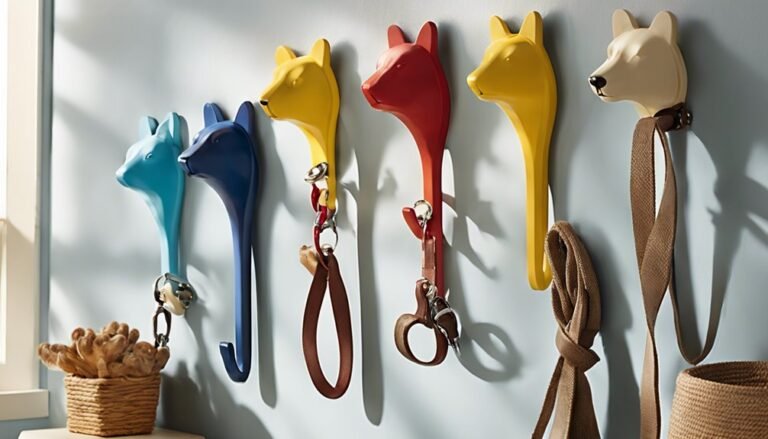How to Install Hooks on Brick Walls
To install hooks on brick walls, start by cleaning the surface and marking the hook placement. Use a hammer drill with masonry bits to create holes in the brick. Insert expansion anchors or sleeve anchors for a secure fit. Attach the hooks, making sure they're level and don't overtighten. Once installed, test their stability by gradually adding weight. This guarantees safety. Want to make certain your installation lasts? Explore more tips and tricks for successful hanging.
Understanding Brick Wall Composition
When you think about brick walls, imagine their sturdy structure and timeless appeal. Understanding brick composition is key to appreciating their durability. Bricks are typically made from clay, shale, or concrete, providing strength and insulation. This composition varies across different wall types, such as solid brick walls or cavity walls. Solid brick walls consist of continuous bricks, offering excellent load-bearing capabilities, while cavity walls feature two layers with an air gap in between, enhancing thermal efficiency. Knowing these differences helps you choose the right installation method for hooks. Each wall type requires specific anchors or fasteners to guarantee stability and security, allowing you the freedom to hang items without worry. Understanding these elements empowers you to create a functional space.
Choosing the Right Hooks
When choosing hooks for your brick wall, it's important to understand the various types available and their specific functions. Consider the weight capacity you'll need, as well as the durability of the materials, to guarantee they can withstand the intended use. Making informed decisions here will help you select the best hooks for your needs.
Hook Types Overview
Choosing the right hooks for your brick wall can greatly impact both functionality and aesthetics. With various hook styles available, you can find options that suit your needs and enhance your space. Consider using wall-mounted hooks for a sturdy solution, or opt for adhesive hooks for a quick, damage-free alternative.
If you're looking to add some flair, explore decorative options like ornate hooks or themed designs that bring personality to your wall. Whether you need simple utility hooks for hanging tools or artistic pieces for showcasing decor, the right choice will reflect your taste and support your lifestyle. Take your time to assess your options, ensuring you find hooks that blend seamlessly with your brick wall while serving your practical needs.
Weight Capacity Considerations
Before you decide on the type of hooks to install, it's important to take into account their weight capacity to confirm they can safely hold the items you plan to hang. Proper weight distribution and load management are vital to avoid accidents and guarantee your items stay secure. Consider the following factors:
- Total Weight: Calculate the combined weight of all items you intend to hang.
- Hook Rating: Check the manufacturer's specifications for each hook's weight limit.
- Distribution Method: If hanging multiple items, confirm weight is evenly distributed across hooks.
Material Durability Factors
Although it might seem like any hook will do, selecting the right material for your hooks is essential for ensuring they withstand the elements and heavy use. You need to take into account weather resistance and load bearing capacity when making your choice. Here's a quick comparison to help you decide:
| Material | Weather Resistance | Load Bearing Capacity |
|---|---|---|
| Steel | High | 50 lbs |
| Stainless Steel | Very High | 75 lbs |
| Plastic | Low | 20 lbs |
| Aluminum | Medium | 30 lbs |
| Brass | Low | 25 lbs |
Tools and Materials Needed
To successfully install hooks on brick walls, you'll need a few essential tools and materials. These items guarantee efficient hook installation while providing wall protection.
- Hammer Drill: This powerful tool allows you to create precise holes in the brick, making it easier to secure your hooks.
- Masonry Drill Bits: You'll need these specialized bits to handle the tough brick material effectively.
- Expansion Anchors: These anchors keep your hooks firmly in place, preventing any damage to the wall while providing strong support.
Gather these tools and materials before you start, and you'll enjoy a hassle-free installation process that respects both your walls and your freedom to arrange your space as you wish.
Preparing the Wall Surface
Once you've gathered your tools and materials, it's essential to prepare the wall surface properly for a successful hook installation. Start by inspecting the brick wall for any dirt, dust, or debris. Using effective cleaning techniques, like a damp cloth or a soft brush, remove any grime to guarantee a clean surface. If you notice any stubborn stains, consider using a mild detergent. Once the wall is clean, allow it to dry completely; moisture can interfere with adhesive or drilling. If there are any loose pieces of mortar, gently scrape them away to create a smooth area for mounting. Proper surface preparation not only enhances the hook's stability but also assures your installation lasts longer.
Marking the Hook Placement
Before you start installing hooks, it's important to mark the correct placement on your brick wall. You'll need a few tools like a measuring tape and a pencil to guarantee accuracy. By measuring the spacing carefully and marking with precision, you can avoid any misalignment when hanging your hooks.
Tools Needed for Marking
When marking the placement for hooks on brick walls, having the right tools is essential for achieving accuracy. You'll want to guarantee you have suitable markers that can stand up to the rough texture of the brick. Here are three key tools you'll need for effective marking techniques:
- Chalk Line: This helps you create straight, visible lines across the wall.
- Pencil or Marker: Use a permanent marker that won't easily smudge or wipe away.
- Level: This guarantees your hooks are straight and evenly spaced.
With these tools in hand, you'll be well-prepared to mark your hook placements accurately, allowing for a clean and professional installation. Enjoy the freedom of creating your space!
Measuring Hook Spacing
Measuring hook spacing accurately is essential for both functionality and aesthetics in your brick wall installation. Start by determining the height for your hooks based on what you'll hang. Use consistent spacing techniques to guarantee a neat appearance. Here's a simple table to guide your measurements:
| Hook Number | Height (inches) | Spacing (inches) |
|---|---|---|
| 1 | 60 | 12 |
| 2 | 60 | 24 |
| 3 | 60 | 36 |
| 4 | 60 | 48 |
| 5 | 60 | 60 |
Marking With Precision
To guarantee your hooks are perfectly aligned, start by carefully marking their placement on the brick wall. Using effective marking techniques guarantees a clean installation. Here's how to do it:
- Select precision tools: Use a level and a measuring tape to establish straight lines.
- Make your marks: Lightly pencil in the hook locations, guaranteeing they match your measurements.
- Double-check alignment: Verify that all marks are even and spaced correctly before drilling.
Drilling Into the Brick
Drilling into brick can seem challenging, but with the right tools and techniques, it's a straightforward task. Start by selecting the appropriate drill bits designed for masonry. Using a hammer drill is ideal for this type of work. Remember to wear safety glasses and a dust mask to protect yourself.
Here's a quick reference table for your drilling needs:
| Tool | Purpose | Tips |
|---|---|---|
| Hammer Drill | Drills into brick | Use slow speed initially |
| Masonry Drill Bits | Penetrates hard surfaces | Verify they're sharp |
| Safety Gear | Protects during drilling | Always wear it |
Installing the Anchors
Once you've successfully drilled into the brick, you'll need to install the anchors to guarantee your hooks are secure. Choosing the right anchor types is essential for a solid hold. Here are some effective installation techniques:
- Expansion Anchors: Insert the anchor into the hole, then tighten the screw to expand it against the brick.
- Sleeve Anchors: Similar to expansion anchors, these provide extra grip with a sleeve that expands when you tighten the screw.
- Toggle Bolts: For heavier items, toggle bolts can provide superior strength; insert them through the hole and activate the toggle behind the brick.
Make sure to follow these steps carefully, and you'll enjoy the freedom to hang whatever you like!
Attaching the Hooks
With the anchors securely installed, you're ready to attach the hooks. First, align your hooks with the anchors, ensuring they're level. Choose the right hook placement techniques based on what you plan to hang—think about weight distribution and accessibility.
Here's a quick guide to help:
| Hook Type | Best Use |
|---|---|
| Heavy-duty hooks | For tools and equipment |
| Decorative hooks | For light items or decor |
| S-hooks | For hanging bags or towels |
| Wall-mounted racks | For organizing larger items |
As you proceed, use these hook installation tips: tighten screws gently but firmly, and avoid overtightening, which could damage the anchors. Enjoy your newly organized space!
Testing the Stability of the Installation
Before you start hanging your items, it's crucial to test the stability of your installation. You want to verify your hooks can support the weight and won't come loose over time. Here are three simple stability tests you can perform:
- Weight Test: Gradually add weight to the hooks, starting with lighter items and increasing to the expected load.
- Shake Test: Gently shake the hooks to see if they remain secure. If they wobble or move, you may need to adjust your installation techniques.
- Visual Inspection: Check for any cracks or loosening in the surrounding brick. This can indicate poor stability.







